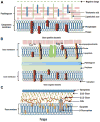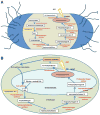Photodynamic therapy for infections: clinical applications
- PMID: 22057503
- PMCID: PMC3449167
- DOI: 10.1002/lsm.21080
Photodynamic therapy for infections: clinical applications
Abstract
Background and objective: Photodynamic therapy (PDT) was discovered over 100 years ago by its ability to kill various microorganisms when the appropriate dye and light were combined in the presence of oxygen. However it is only in relatively recent times that PDT has been studied as a treatment for various types of localized infections. This resurgence of interest has been partly motivated by the alarming increase in drug resistance amongst bacteria and other pathogens. This review will focus on the clinical applications of antimicrobial PDT.
Study design/materials and methods: The published peer-reviewed literature was reviewed between 1960 and 2011.
Results: The basics of antimicrobial PDT are discussed. Clinical applications of antimicrobial PDT to localized viral infections caused by herpes and papilloma viruses, and nonviral dermatological infections such as acne and other yeast, fungal and bacterial skin infections are covered. PDT has been used to treat bacterial infections in brain abscesses and non-healing ulcers. PDT for dental infections including periodontitis and endodontics has been well studied. PDT has also been used for cutaneous Leishmaniasis. Clinical trials of PDT and blue light alone therapy for gastric Helicobacter pylori infection are also covered.
Conclusion: As yet clinical PDT for infections has been mainly in the field of dermatology using 5-aminolevulanic acid and in dentistry using phenothiazinium dyes. We expect more to see applications of PDT to more challenging infections using advanced antimicrobial photosensitizers targeted to microbial cells in the years to come.
Copyright © 2011 Wiley-Liss, Inc.
Figures





References
-
- Athar M, Mukhtar H, Bickers DR. Differential role of reactive oxygen intermediates in photofrin-I- and photofrin-II-mediated photoenhancement of lipid peroxidation in epidermal microsomal membranes. J Invest Dermatol. 1988;90(5):652–657. - PubMed
-
- Redmond RW, Gamlin JN. A compilation of singlet oxygen yields from biologically relevant molecules. Photochem Photobiol. 1999;70(4):391–475. - PubMed
-
- Bockstahler LE, Lytle CD, Hellman KB. A review of photodynamic therapy for herpes simplex: Benefits and potential risks. NY J Dent. 1975;45(5):148–157. - PubMed
-
- Myers MG, Oxman MN, Clark JE, Arndt KA. Failure of neutral-red photodynamic inactivation in recurrent herpes simplex virus infections. N Engl J Med. 1975;293(19):945–949. - PubMed
-
- Chang TW. Letter: Viral photoinactivation and oncogenesis. Arch Dermatol. 1976;112(8):1176. - PubMed
Publication types
MeSH terms
Substances
Grants and funding
LinkOut - more resources
Full Text Sources
Other Literature Sources
Medical
Research Materials

